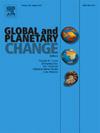自更新世中期以来气候变化和富甲烷流体活动对南海北部沉积硫地球化学记录的影响
IF 4
1区 地球科学
Q1 GEOGRAPHY, PHYSICAL
引用次数: 0
摘要
微生物硫酸盐还原(MSR)和相关的黄铁矿硫化物形成是海洋沉积物中重要的成岩过程。事实证明,黄铁矿的硫同位素组成(δ34Spyr)对沉积速率的变化以及有机碳的含量和反应性非常敏感,尤其是在大陆架和上斜坡(水深 350 米)。然而,人们对深海沉积物中硫对气候和沉积条件变化的成岩反应仍然知之甚少。本研究结合元素含量和同位素,描述了自更新世中期以来南海北部大陆坡沉积物中硫、有机碳和甲烷的成因相互作用特征。我们的数据表明,总有机碳(TOC)在冰川时期有所增加,这意味着由于东亚冬季季候风增加了养分供应,除了有机碳的有效转移和底层水氧的减少使有机碳得到更好的保存之外,初级生产力也得到了提高。总硫和铬还原硫含量随总有机碳含量的变化而变化,表明有机碳的埋藏量增加,促进了有机脆性硫酸盐还原(OSR)和自生黄铁矿的形成。环境变化并没有引起δ34Spyr的显著变化,这很可能是由于在冰川-间冰期循环过程中,沉积速率相对较低,而且通过OSR对硫同位素进行了大量分馏。相反,据推测,硫酸盐驱动的厌氧甲烷氧化促进了更多自生黄铁矿的形成。因此,它形成了一个封闭的成岩系统,导致硫酸盐-甲烷过渡带的δ34Spyr出现正向偏移。我们的研究结果表明,黄铁矿的形成及其硫同位素组成很容易受到季风驱动的初级生产力变化和大陆边缘沉积物中富含甲烷的流体迁移的影响。这项研究补充了越来越多的关于沉积硫地球化学记录受局部成岩作用控制的证据,强调了基于黄铁矿含量和硫同位素组成的早期成岩作用在古环境重建中的重要性。本文章由计算机程序翻译,如有差异,请以英文原文为准。
Effects of climate change and methane-rich fluid activity on sedimentary sulfur geochemical records in the northern South China Sea since mid-Pleistocene
Microbial sulfate reduction (MSR) and associated pyritic sulfide formation are important diagenetic processes in marine sediments. The sulfur isotopic composition of pyrite (δ34Spyr) is proven to be sensitive to changes in sedimentation rates and the content and reactivity of organic carbon, especially on the continental shelves and upper slopes (water depth < 350 m). However, the diagenetic responses of sulfur to variations in climatic and depositional conditions in the deep-sea sediments are still poorly understood. This study combines element contents and isotopes to characterize diagenetic interplays of sulfur, organic carbon, and methane in the continental slope sediments of the northern South China Sea since the mid-Pleistocene. Our data suggest that the total organic carbon (TOC) increased during glacial times, implying enhanced primary productivity due to increased nutrient supply by the East Asian Winter Monsoon, in addition to efficient transfer of organic carbon and better preservation of organic carbon due to reduced bottom water oxygen. Total sulfur and chromium reduction sulfur contents varied concomitantly with the TOC, suggesting an increased burial of organic carbon that enhanced the organoclastic sulfate reduction (OSR) and the formation of authigenic pyrite. The environmental changes did not induce a significant shift in δ34Spyr, due most likely to relatively low sedimentation rates and large fractionation in sulfur isotope through OSR during the glacial-interglacial cycles. Instead, it is hypothesized that the sulfate-driven anaerobic methane oxidation promoted the formation of a higher amount of authigenic pyrite. Consequently, it created a closed diagenetic system leading to positive excursions in δ34Spyr at the sulfate-methane transition zone. Our results suggest the vulnerability of pyrite formation and its sulfur isotopic composition to the changes in monsoon-driven primary productivity and the methane-rich fluid migrations in the continental margin sediments. This study complements the growing evidence for the local diagenetic controls on sedimentary sulfur geochemical records by highlighting the importance of early diagenesis in paleoenvironment reconstruction based on the content and sulfur isotopic composition of pyrite.
求助全文
通过发布文献求助,成功后即可免费获取论文全文。
去求助
来源期刊

Global and Planetary Change
地学天文-地球科学综合
CiteScore
7.40
自引率
10.30%
发文量
226
审稿时长
63 days
期刊介绍:
The objective of the journal Global and Planetary Change is to provide a multi-disciplinary overview of the processes taking place in the Earth System and involved in planetary change over time. The journal focuses on records of the past and current state of the earth system, and future scenarios , and their link to global environmental change. Regional or process-oriented studies are welcome if they discuss global implications. Topics include, but are not limited to, changes in the dynamics and composition of the atmosphere, oceans and cryosphere, as well as climate change, sea level variation, observations/modelling of Earth processes from deep to (near-)surface and their coupling, global ecology, biogeography and the resilience/thresholds in ecosystems.
Key criteria for the consideration of manuscripts are (a) the relevance for the global scientific community and/or (b) the wider implications for global scale problems, preferably combined with (c) having a significance beyond a single discipline. A clear focus on key processes associated with planetary scale change is strongly encouraged.
Manuscripts can be submitted as either research contributions or as a review article. Every effort should be made towards the presentation of research outcomes in an understandable way for a broad readership.
 求助内容:
求助内容: 应助结果提醒方式:
应助结果提醒方式:


